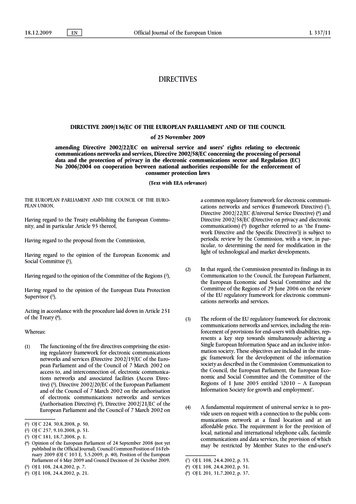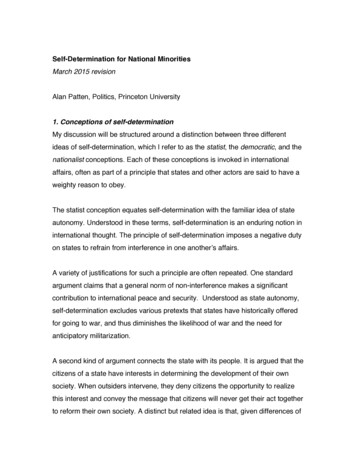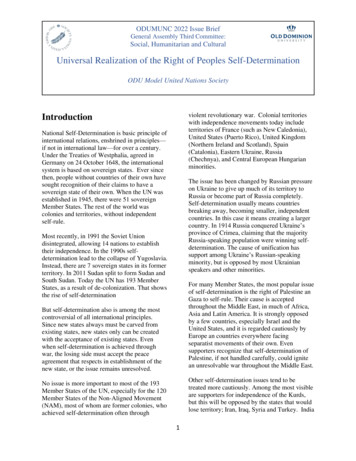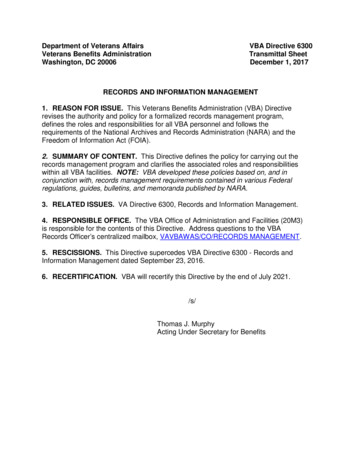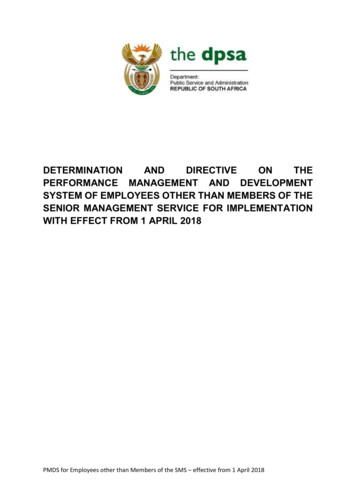
Transcription
DETERMINATIONANDDIRECTIVEONTHEPERFORMANCE MANAGEMENT AND DEVELOPMENTSYSTEM OF EMPLOYEES OTHER THAN MEMBERS OF THESENIOR MANAGEMENT SERVICE FOR IMPLEMENTATIONWITH EFFECT FROM 1 APRIL 2018PMDS for Employees other than Members of the SMS – effective from 1 April 2018
Table of Contents1.INTRODUCTION . 12.AUTHORIZATION . 13.SCOPE OF APPLICABILITY . 14.DATE OF IMPLEMENTATION . 15.COMPLIANCE . 16.PERFORMANCE MANAGEMENT AND DEVELOPMENT SYSTEM FOR EMPLOYEESOTHER THAN SMS MEMBERS . 27.PERFORMANCE AGREEMENT OR AN AGREEMENT OF A SIMILAR NATURE . 28.PERFORMANCE MONITORING, REVIEW AND ASSESSMENT . 49.PERFORMANCE MANAGEMENT COMPLIANCE DUE DATES AND ACTIVITIES . 510. PERFORMANCE MODERATION. 511. COMPULSORY CAPTURING OF EMPLOYEE PERFORMANCE MANAGEMENTINFORMATION . 712. PROLONGED ABSENCE DURING THE PERFORMANCE CYCLE . 713. MANAGING PERFORMANCE OUTCOMES . 714. MECHANISM FOR THE RESOLUTION OF PERFORMANCE MATTERS . 815. ANNEXURES . 815.1.Annexure A . 815.2.Annexure B . 8CHECKLIST OF THE DETERMINATION AND DIRECTIVE WITH THE PUBLIC SERVICEREGULATIONS 2016 . 9PMDS for Employees other than Members of the SMS – effective from 1 April 2018
1.INTRODUCTION1.1.Section 3 of the Public Service Act, 1994, provides that the Minister for the PublicService and Administration (MPSA) is responsible for establishing norms andstandards relating to, among others, employment practices for employees whichincludes performance management. The MPSA can determine these norms andstandards by making regulations, determinations and directives.1.2.In terms of the Public Service Regulations, 2016 (PSR) an executive authority (EA)shall approve and implement a system for the performance management ofemployees, other than employees who are members of the Senior ManagementService (SMS), and may also establish separate Performance Management Systemsfor different occupational categories or levels of work in his or her department.1.3.Clause 12.1 of the Public Service Co-ordinating Bargaining Council (PSCBC)Resolution 1 of 2012 (Wage Agreement for 2012/2013), provides that the employer willreview the current PMDS for employees on salary levels 1 to 12. The PSR has beenamended to give effect to and incorporate the changes in the performancemanagement for employees other than members of the SMS.1.4.Chapter 4, Part 5 of the PSR provides norms and standards on the PerformanceManagement and Development Systems (PMDS) for non-SMS employees which mustbe included in the departmental PMDS. This Determination and Directive onperformance management for employees other than employees who are members ofthe Senior Management Service (SMS) seeks to elucidate and supplement the PSRas well as to provide guidance to departments on areas requiring revision in theirdepartmental PMDS policies.1.5.National and Provincial departments are expected to review/amend their PMDSpolicies and align them to the PSR and this Determination and Directive.2.AUTHORIZATION2.1.This Determination and Directive is issued in terms of sections 3(1), 3(2) and 41(3) ofthe Public Service Act, 1994 read with regulations 71 and 72 of PSR.3.SCOPE OF APPLICABILITY3.1.This Determination and Directive is applicable to all employees, other than membersof the Senior Management Services (SMS).4.DATE OF IMPLEMENTATION4.1.This Determination and Directive will be effective from 1 April 2018.5.COMPLIANCE5.1Any non-compliance with this Determination and Directive must be dealt with in termsof section 16A of the Public Service Act.1PMDS for Employees other than Members of the SMS – effective from 1 April 2018
6.PERFORMANCE MANAGEMENT AND DEVELOPMENT SYSTEM FOREMPLOYEES OTHER THAN SMS MEMBERS6.1.In terms of regulation (71)(1) of the PSR, Executive Authorities (EAs) are expected toapprove and implement a PMDS policy for employees other than employees who aremembers of the SMS. The performance management cycle is linked to a financial yeartherefore, the PMDS policy should be approved by an EA prior to the performancecycle for which the system is to be implemented. The EA may establish separateperformance management systems for different occupational categories or levels ofwork.6.2The PMDS policy for employees other than SMS members shall hinge on the followingdimensions:6.2.1 Key Result Areas (KRAs), describe the core functions or broad area of responsibilityof an employee. It is broken down into number of outputs and activities.6.2.2 Generic Assessment Factors (GAFs), describe the competency requirements takinginto consideration the knowledge, skills and attributes relevant to the employee’s work.6.3Departments shall develop their own templates which will be used for performancecontracting, review and assessments.6.4An EA may use a single assessment instrument to assist in deciding on an employee’sprobation and performance.6.5.Performance Agreements (PAs) or an agreement of similar nature must be signed byboth parties (i.e. the employee and the supervisor) for it to be valid and binding.6.6.An employee acting in a higher position shall be assessed at the level of his or her postthat he or she occupied at the time immediately prior to the acting position and theawarding of performance incentives if he/she qualifies shall be calculated on the lowerlevel.6.7.Any deviation from the provisions of the system during the cycle may be approved bythe relevant executive authority only if such deviation is not to the detriment of anyemployee and is not inconsistent with the provisions of the Public Service Act, the PSRand this Determination and Directive.7.PERFORMANCE AGREEMENT OR AN AGREEMENT OF A SIMILARNATURE7.1The PMDS policies of departments shall provide for the employee and supervisor toenter into a performance agreement or an agreement of a similar nature.7.2.All employees shall conclude and sign their Performance Agreements (PAs) or anagreement of similar nature on or before 31 May of each financial year. The relevantsupervisor shall ensure that the signed PAs or agreements of similar nature aresubmitted to their internal Human Resource Management components on or beforethe end of the first working day following the due date for signing of PAs or agreementof similar nature. The EA or delegated official may include internal departmentaltimelines in their PMDS policies to ensure compliance with these dates. Newly2PMDS for Employees other than Members of the SMS – effective from 1 April 2018
appointed employees shall conclude, sign and file their PAs or an agreement of similarnature within three months of the date of appointment and thereafter, within twocalendar months of the beginning of each financial year (Regulation 72(1) of the PSR).7.3An employee who is appointed, seconded or transferred to another post or position atthe same salary level must enter into a new PA or agreement of a similar nature forthe new post or position within three calendar months of his/herappointment/secondment/transfer (Regulation 72 (2) of the PSR). For secondedemployees, a copy of the signed PA or agreement of similar nature must be submittedby the seconding department to the releasing department within 30 days.7.4.An employee who does not comply with the requirements in paragraphs 7.1, 7.2 and7.3 above, shall not qualify for any performance rewards, i.e. pay progression andperformance bonus (Regulation 72(7) of the PSR).7.5.Employees are discouraged from amending a PA or an agreement of a similar naturein the last quarter of a performance cycle (i.e. 1 January to 31 March), unless changesto the employee job description, job grade, organisational structure of the departmentor its functions or amendments to the objectives and priorities result in significantchanges to the content of the job of the employee.7.6.In the case where the amendment of the PA or an agreement of a similar nature isjustified, the amended PA or agreement of a similar nature must be accompanied by awritten motivation explaining the reasons for the changes. This motivation must besigned by supervisor and the head of the component and submitted to HRM unit toinform and clarify matters of performance during annual assessments and moderation.7.7.Contents of the PA or an agreement of a similar nature7.7.1. In terms of Regulation 72(3), as a minimum, a PA or an agreement of a similar natureshall include the following:7.7.2(a)A personnel number, job title, post grade as well as a clear description of themain objectives of the employee’s job and the key responsibility areas (KRAs),relevant outputs and competency requirements (GAFs);(b)A workplan containing the outputs, activities and resource requirements; and(c)A personal development plan (PDP) that identifies the employee's competencyand developmental needs in terms of the inherent requirements of the job, aswell as methods to improve these.Each KRA should be weighted as a percentage (%) according to the level ofimportance and impact it has in the employee’s job. The weighting of all the KRAsshould aggregate to 100%. The weight of each KRA shall not be less than 10% andshall not exceed 30%.7.7.3 Employees shall identify, discuss and agree on the GAFs that are most relevant to theirarea of work. The GAFs shall not be weighted. GAFs shall not be assessedindependently, but must be incorporated and assessed in an integrated manner withthe KRAs. Any employee development identified in the GAFs shall be used to informareas of development to be included in the PDP of employees. A list of the GAFs isattached as Annexure A.7.7.4 Departments may develop their own templates for performance agreements, mid-yearreviews and annual assessments.3PMDS for Employees other than Members of the SMS – effective from 1 April 2018
8.PERFORMANCE MONITORING, REVIEW AND ASSESSMENT8.1.The performance of employees must be monitored by supervisors on a continuousbasis, with oral feedback on an employee’s performance if the performance issatisfactory and in writing if the employee’s performance is unsatisfactory.8.2.The conducting of mid-year performance reviews and annual performanceassessments are compulsory, and must be in writing. The annual assessment shallreflect the performance of the employee for the entire performance cycle (April toMarch). The annual assessment must be conducted even if the employee wasemployed for less than 12 months in that cycle.8.3.A four (4) point rating scale shall be used to assess the performance of employeeswho are employees other than members of the SMS. A rating of a “3” on the scaleentails “fully effective”. In terms of this approach to performance rating, an employeewho is rated “fully effective” has fully complied with the requirements of the job. Onthe rating scale, this translates to an overall score of 100%. Only whole numbers mustbe used in the scoring (no decimals numbers are allowed (e.g. 3.5)).8.3.1. Table 1 below provides an explanation of the four point rating scale, categories ofperformance and the associated descriptions.RATING1CATEGORY ANDSCORENot effective(less than or equalto 66%)2Partially Effective(67%-99%)3Fully Effective(100% - 119%)4Highly Effective(120% - 133%)DESCRIPTIONPerformance does not meet the expected standard for thejob. The review / assessment indicates that the jobholderhas achieved less than fully effective results against all oralmost all of the performance criteria and indicators asspecified in the Performance Agreement and Workplan.Performance meets some of the standards expected for thejob. The review/assessment indicates that the jobholderhas achieved less than fully effective results (partiallyachieved) against more than half of the performancecriteria and indicators as specified in the PerformanceAgreement and Workplan.Performance fully meets the standard expected in all areasof the job. The review / assessment indicates that thejobholder has achieved as a minimum effective resultsagainst all of the performance criteria and indicators asspecified in the Performance Agreement and Workplan.Performance far exceeds the standard expected of ajobholder at this level. The review/assessment indicatesthat the jobholder has achieved better than fully effectiveresults against more than half/or in all areas of theperformance criteria and indicators as specified in the PAand Workplan and maintained this in all areas ofresponsibility throughout the performance cycle.Table 1: Four (4) Point Rating Scale8.3.2. The performance assessment calculator shall be used to calculate the overallperformance score(s) of the mid-year reviews and the annual performanceassessment (Annexure B). The electronic Excel Performance Assessment Calculatorfor non-SMS employees is available on the DPSA website (www.dpsa.gov.za).4PMDS for Employees other than Members of the SMS – effective from 1 April 2018
9.PERFORMANCE MANAGEMENT COMPLIANCE DUE DATES ANDACTIVITIES9.1.Table 2 provides the compliance due dates that are prescribed in terms of the PublicService Regulations, 2016 and directives issued by the MPSA. EAs and HODs mustensure that their PMDS policy and procedures comply with the specified dates andtimeframes contained in the PSR.AnnualDatesCurrent Cycle Activities31 MaySigned PA isfiled/submitted to HR*Previous CycleActivities to becompletedResponsibilityEmployee,supervisor andHead of HR30 JuneFinalisation of capturing ofsigned performanceagreements on PERSALFinalisation ofcapturing of employeeperformanceinformation onPERSALHead of HR andHR informationsystem/PersalController31 JulyFinalisation of annualperformanceassessmentsEmployee,supervisor and EAor delegatedofficialEmployee andsupervisorEA or delegatedAuthority31 OctoberFinalisation of mid-yearreviews30 NovemberApproval ofmoderated annualperformanceassessmentsImplementation ofoutcomes of theannual performance31 DecemberHR/FinanceandAccounting OfficerTable 2*Note: New employees must sign PAs within three calendar months of the date of his/herdate of appointment.10.PERFORMANCE MODERATION10.1. In terms of Regulation 71(5)(e), the PMDS of departments must provide forarrangements and structures for the purpose of performance moderation to ensurefairness and consistent application of the employee performance management system.10.2The EA or relevant delegated authority/ies shall appoint a committee to moderate theannual performance assessments and submit the recommendations to the relevant EAfor approval.5PMDS for Employees other than Members of the SMS – effective from 1 April 2018
10.3. The performance moderation is conducted by a higher level of management above thesupervisor to ensure, as far as possible, that the performance of all employees isevaluated fairly and consistently across the department.10.4. Members of Moderation Committees must ensure that:10.4.1 There is compliance with the public service prescripts in terms of the timelines on thesigning of PAs or agreements of a similar nature, performance reviews andassessments and the date for the implementation of the outcomes of annualperformance assessments; and10.4.2 The performance outcome of the department/branch or unit is considered whenadvising or/ recommending on the implementation of the outcomes of annualperformance assessments.10.5. The performance moderation processes may be conducted in two steps if so desired,i.e. the intermediate review committee (optional) and departmental moderationcommittee (compulsory), which are discussed below.10.6The intermediate review committee (IRC)-Optional10.6.1. Departments may establish an Intermediate Review Committee (IRC) at a Programmeor Chief Directorate level for reviewing the performance assessment rating agreedupon by the employee and the supervisor. The need for such a committee will dependon the size and structure of the department.10.6.2. The IRC receives the performance assessment ratings of all employees in the ChiefDirectorate or Component level, to review, compare and validate the ratings. If the IRCagrees with the ratings, the ratings are then submitted to the moderating committee.Any recommendation on the changing of the rating scores must be referred back tothe employee’s supervisor for the supervisor and the subordinate to try and reachconsensus on the change. If the supervisor and the employee cannot agree, theunchanged/original rating is forwarded to the Moderating Committee, with thecomments from the IRC, the supervisor and employee.10.7.Departmental Moderating Committee (DMC) (Mandatory)10.7.1. Each EA or the relevant delegated authority/ies, must establish a DepartmentalModerating Committee (DMC) for employees other than members of the SMS, whichis chaired by the Head of Department (HOD) or his/her delegate. The Committeefurthermore, may consist of senior managers at the discretion of the EA or relevantdelegated official.10.7.2. Roles of the DMC(a).The role of the Departmental Moderating Committee is to ensure that theannual performance assessment is done in a realistic, consistent and fairmanner, to monitor the performance assessment process by obtaining anoverall sense of whether norms and standards are being applied consistentlyand realistically to employees on the same level and across the department asa whole.(b).The DMC should not assess each individual case for purposes of evaluatingratings, but should develop an overall view of the results of the assessmentprocess. If the DMC identifies deviations or discrepancies, these should bedealt with in a just, fair and consistent manner.6PMDS for Employees other than Members of the SMS – effective from 1 April 2018
(c).The DMC must keep detailed minutes and records of decisions, in particular, ifit recommends either increasing or decreasing rating scores. Such decisionsmust be communicated to the supervisor and the employee.(d).The Moderating Committee shall confirm the rating, which is the final ratingscore for an employee.10.7.3. The other additional roles of the Departmental Moderating Committee thereforeinclude –(a)Provision of oversight of the application of the PMDS policies, ensuring that theperformance management process, including the setting of performancestandards is valid, fair and objective;(b)Detection of potential problems in the PMD system and advising the HODaccordingly;(c)Reviewing overall assessment scores across unit sections/programmes in thedepartment;(d)Recommending reward levels and remedial action for different types ofperformance outcomes; and(e)Making recommendations regarding actions to be considered where managersand supervisors do not properly and fairly execute their responsibilities withregard to contracting, provision of performance feedback, mid-year reviews,annual assessment and rating in terms of the PMDS.11.COMPULSORY CAPTURING OF EMPLOYEE PERFORMANCEMANAGEMENT INFORMATION11.1All Heads of Department and Government Components must ensure the employees’performance information is captured on PERSAL or a system determined by the MPSA(PSR 71(7)).12.PROLONGED ABSENCE DURING THE PERFORMANCE CYCLE12.1. If an employee is absent with permission or on precautionary suspension for acontinuous period of three (3) months or longer, the affected employee shall beregarded as having performed satisfactorily for that period of absence within thatapplicable performance cycle (Regulation 72 (12)).12.2. Periods of prolonged absence with permission for purposes of paragraph 12.1 aboveinclude all types of approved leave.13.MANAGING PERFORMANCE OUTCOMES13.1. Managing unsatisfactory and poor performanceSupervisors are required to identify and then, in line with a developmental approach,deal with poorly performing employees under their supervision. The supervisor mustcomply with the procedural requirements of PSCBC Resolution 10 of 1999 andResolution 1 of 2013, the “Incapacity Code”.7PMDS for Employees other than Members of the SMS – effective from 1 April 2018
13.2Rewarding good performanceEAs must determine an appropriate reward scale in the establishment of performanceincentive schemes to reward employees or any category of employees ascontemplated in regulation 73(1) of the Public Service Regulations. Where applicable,EAs may subcategorise the overall rating scale of 4 referred to in paragraph 8.3.1above to distinguish between above average performance and excellent performancefor purposes of rewarding employees in terms of the incentive scheme so establishedby an EA.14.MECHANISM FOR THE RESOLUTION OF PERFORMANCE MATTERSMechanisms for dispute resolution must include any differences which might arise outof performance agreements, performance review and assessment. Any disagreementmust first be resolved internally within the Unit/Component/Branch.14.1. Mechanisms for dispute resolution pertaining to a PA/Agreement of a similarnature14.1.1 If a dispute arises as contemplated in regulation 72(4) of the PSR, the EA or delegatedofficial shall appoint a mediator, who shall be an employee, to consider the disputewithin one (1) month after the expiry of the due date for signing of the PA or anagreement of a similar nature.14.1.2 Persons appointed to resolve disputes should preferably be chosen on the basis oftheir functional expertise and people skills and not necessarily a legal qualificationsince performance disagreements should preferably be a consensus driven processresolved through dialogue.14.1.3 The PMDS mediation process shall not exceed a period of one month.14.1.4 If the mediation process fails, an employee may consider a formal grievance in termsof the Public Service Grievance Procedure.15.ANNEXURES15.1. Annexure AList of Generic Assessment Factors15.2. Annexure BAssessment Rating Calculator8PMDS for Employees other than Members of the SMS – effective from 1 April 2018
CHECKLIST OF THE DETERMINATION AND DIRECTIVE WITH THE PUBLICSERVICE REGULATIONS 2016DETERMINATION AND DIRECTIVEPSR 20161.Scope of ApplicationSection 71. (1)2.PerformanceManagementandDevelopment System for non-SMSemployeesPerformance Agreement or anagreement of a similar naturePerformance monitoring, review andassessmentPerformance Management compliancedates and activitiesPerformance moderationSection 713.4.5.6.7.Section 72 (1)Section 71(5)Section 71 and 72Section 71 (5 )8.Compulsory capturing of employee Section 71 (7)performance management informationDisputes resolutionSection 72 (4)9.Prolonged absence10. Managing unsatisfactoryperformanceSection 72 (12)andpoor Section 72 (15)9PMDS for Employees other than Members of the SMS – effective from 1 April 2018
6. PERFORMANCE MANAGEMENT AND DEVELOPMENT SYSTEM FOR EMPLOYEES OTHER THAN SMS MEMBERS 6.1. In terms of regulation (71)(1) of the PSR, Executive Authorities (EAs) are expected to approve and implement a PMDS policy for employees other than employees who are members of the SMS. The performance management cycle is linked to a financial year




